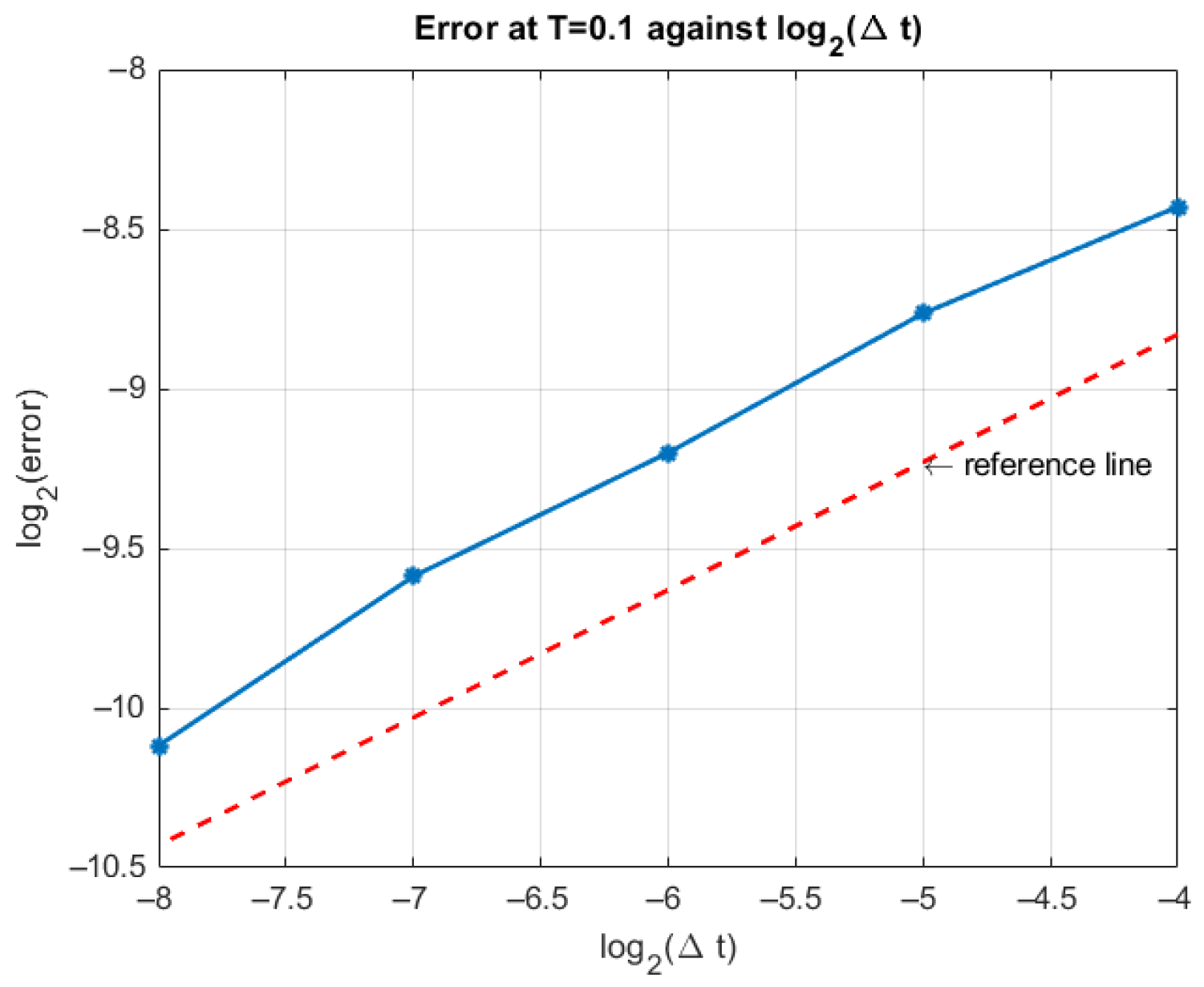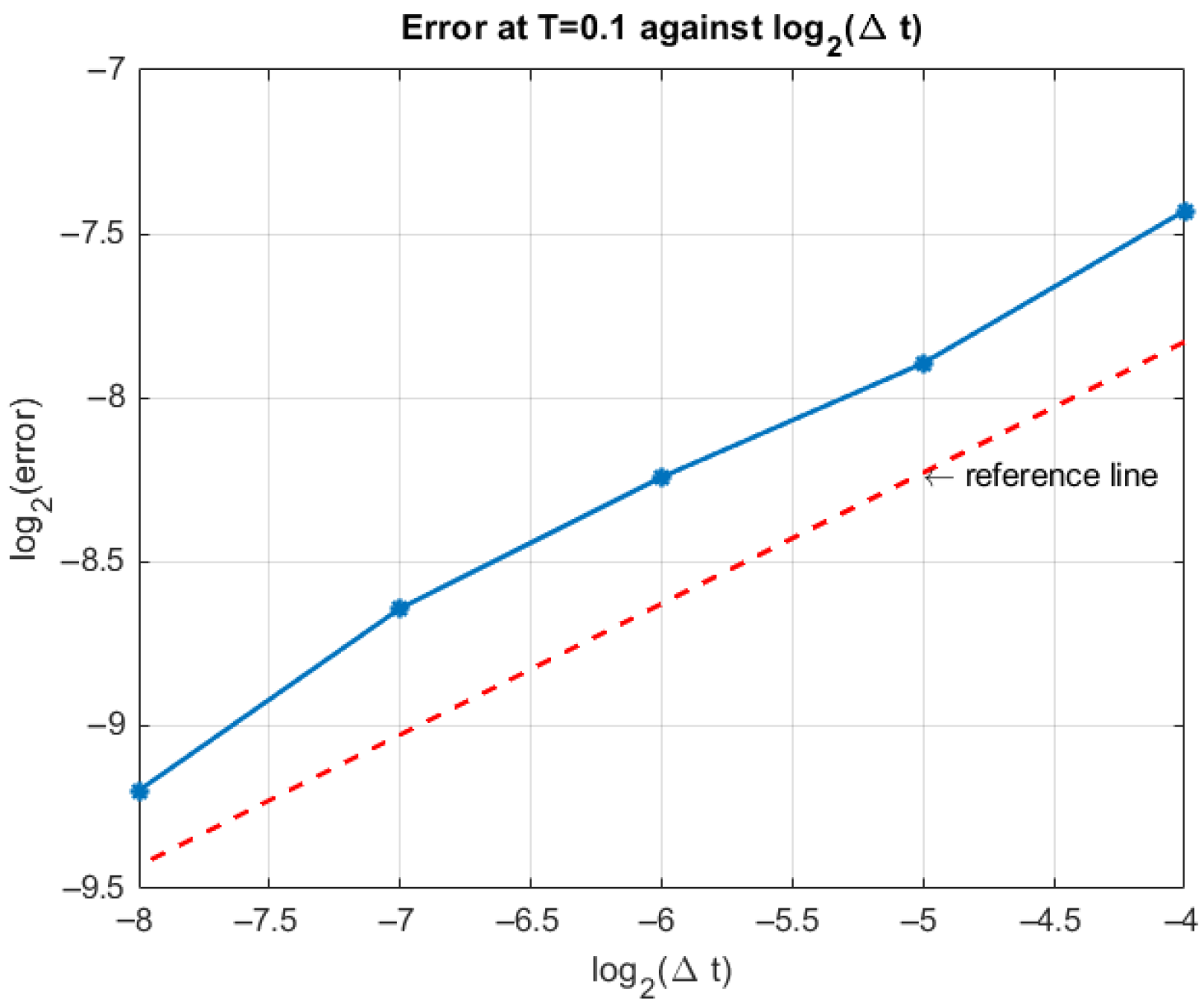Numerical Approximation for a Stochastic Caputo Fractional Differential Equation with Multiplicative Noise
Abstract
1. Introduction
- A regularized stochastic Volterra integral equation is derived by approximating the noise with a piecewise constant function.
- The stability of the regularized stochastic Volterra integral equation is rigorously analyzed.
- The convergence order of the approximation error is shown to be for both additive and multiplicative noise cases, where .
2. The Additive Noise Case
3. The Multiplicative Noise Case
4. Numerical Simulations
Step-by-Step Algorithm
- Step 1
- Step 2
- Step m
5. Conclusions
Author Contributions
Funding
Data Availability Statement
Conflicts of Interest
References
- Li, M.; Huang, C.; Hu, Y. Numerical methods for stochastic Volterra integral equations with weakly singular kernels. IMA J. Numer. Anal. 2022, 42, 2656–2683. [Google Scholar] [CrossRef]
- Diethelm, K. The Analysis of Fractional Differential Equations; Lecture Notes in Mathematics; Springer: Berlin/Heidelberg, Germany, 2010. [Google Scholar]
- Kloeden, P.E.; Platen, E. Numerical Solution of Stochastic Differential Equations; Applications of Mathematics (New York); Springer: Berlin/Heidelberg, Germany, 1992; Volume 23. [Google Scholar]
- Milstein, G.N.; Tretyakov, M.V. Stochastic Numerics for Mathematical Physics; Scientific Computation; Springer: Berlin/Heidelberg, Germany, 2004. [Google Scholar]
- Tudor, C.; Tudor, M. Approximation schemes for Itô–Volterra stochastic equations. Bol. Soc. Mat. Mex. 1995, 1, 73–85. [Google Scholar]
- Wen, C.H.; Zhang, T.S. Improved rectangular method on stochastic Volterra equations. J. Comput. Appl. Math. 2011, 235, 2492–2501. [Google Scholar] [CrossRef]
- Wang, Y. Approximate representations of solutions to SVIEs, and an application to numerical analysis. J. Math. Anal. Appl. 2017, 449, 642–659. [Google Scholar] [CrossRef]
- Xiao, Y.; Shi, J.N.; Yang, Z.W. Split-step collocation methods for stochastic Volterra integral equations. J. Integral Equ. Appl. 2018, 30, 197–218. [Google Scholar] [CrossRef]
- Liang, H.; Yang, Z.; Gao, J. Strong superconvergence of the Euler–Maruyama method for linear stochastic Volterra integral equations. J. Comput. Appl. Math. 2017, 317, 447–457. [Google Scholar] [CrossRef]
- Dai, X.; Bu, W.; Xiao, A. Well-posedness and EM approximations for non-Lipschitz stochastic fractional integro-differential equations. J. Comput. Appl. Math. 2019, 356, 377–390. [Google Scholar] [CrossRef]
- Gao, J.; Liang, H.; Ma, S. Strong convergence of the semi-implicit Euler method for nonlinear stochastic Volterra integral equations with constant delay. Appl. Math. Comput. 2019, 348, 385–398. [Google Scholar] [CrossRef]
- Yang, H.; Yang, Z.; Ma, S. Theoretical and numerical analysis for Volterra integro-differential equations with Itô integral under polynomially growth conditions. Appl. Math. Comput. 2019, 360, 70–82. [Google Scholar] [CrossRef]
- Zhang, W. Theoretical and numerical analysis of a class of stochastic Volterra integro-differential equations with non-globally Lipschitz continuous coefficients. Appl. Numer. Math. 2020, 147, 254–276. [Google Scholar] [CrossRef]
- Zhang, W.; Liang, H.; Gao, J. Theoretical and numerical analysis of the Euler–Maruyama method for generalized stochastic Volterra integro-differential equations. J. Comput. Appl. Math. 2020, 365, 17. [Google Scholar] [CrossRef]
- Kamrani, M. Numerical solution of stochastic fractional differential equations. Numer. Algorithms 2015, 68, 81–93. [Google Scholar] [CrossRef]
- Hoult, J.; Yan, Y. Numerical approximation for a stochastic fractional differential equation driven by integrated multiplicative noise. Mathematics 2024, 3, 265. [Google Scholar] [CrossRef]
- Mohammadi, F.; Ciancio, A. Wavelet-based numerical method for solving fractional integro-differential equation with a weakly singular kernel. Wavelet Linear Algebra 2017, 4, 53–73. [Google Scholar]
- Zhang, X. Euler schemes and large deviations for stochastic Volterra equations with singular kernels. J. Differ. Equ. 2008, 244, 2226–2250. [Google Scholar] [CrossRef]
- Asadzade, J.A.; Mahmudov, N.I. Euler-Maruyama approximation for stochastic fractional neutral integro-differential equations with weakly singular kernel. Phys. Scr. 2024, 99, 075281. [Google Scholar] [CrossRef]
- Anh, P.T.; Doan, T.S.; Huong, P.T. A variation of constant formula for Caputo fractional stochastic differential equations. Statist. Probab. Lett. 2019, 145, 351–358. [Google Scholar] [CrossRef]
- Son, D.T.; Huong, P.T.; Kloeden, P.E.; Tuan, H.T. Asymptotic separation between solutions of Caputo fractional stochastic differential equations. Stoch. Anal. Appl. 2018, 36, 654–664. [Google Scholar] [CrossRef]
| β | EOC | |||||
|---|---|---|---|---|---|---|
| 0.5 | 0.2318 | |||||
| 0.1795 | 0.2101 | 0.2581 | 0.2796 | |||
| 0.6 | 0.2221 | |||||
| 0.1376 | 0.2083 | 0.1842 | 0.3584 | |||
| 0.7 | 0.4071 | |||||
| 0.4297 | 0.4353 | 0.3849 | 0.3785 | |||
| 0.8 | 0.4631 | |||||
| 0.3387 | 0.4137 | 0.4840 | 0.6161 | |||
| 0.9 | 0.5057 | |||||
| 0.5261 | 0.4837 | 0.5267 | 0.4863 |
| α | EOC | |||||
|---|---|---|---|---|---|---|
| 0.5 | 0.5070 | |||||
| 0.4599 | 0.4600 | 0.5817 | 0.5264 | |||
| 0.6 | 0.4407 | |||||
| 0.4645 | 0.4331 | 0.4297 | 0.4353 | |||
| 0.7 | 0.4504 | |||||
| 0.3883 | 0.5065 | 0.4067 | 0.5002 | |||
| 0.8 | 0.5364 | |||||
| 0.4073 | 0.4840 | 0.5562 | 0.6982 | |||
| 0.9 | 0.5057 | |||||
| 0.5261 | 0.4837 | 0.5267 | 0.4863 |
| β | EOC | |||||
|---|---|---|---|---|---|---|
| 0.5 | 0.2289 | |||||
| 0.1805 | 0.1839 | 0.2918 | 0.2595 | |||
| 0.6 | 0.2261 | |||||
| 0.1422 | 0.2046 | 0.2191 | 0.3387 | |||
| 0.7 | 0.3161 | |||||
| 0.2349 | 0.3800 | 0.2616 | 0.3879 | |||
| 0.8 | 0.4609 | |||||
| 0.3412 | 0.4108 | 0.4773 | 0.6145 | |||
| 0.9 | 0.4057 | |||||
| 0.3849 | 0.4497 | 0.4397 | 0.3485 |
| α | EOC | |||||
|---|---|---|---|---|---|---|
| 0.5 | 0.5159 | |||||
| 0.4549 | 0.4708 | 0.5870 | 0.5508 | |||
| 0.6 | 0.4399 | |||||
| 0.3594 | 0.4120 | 0.3642 | 0.6240 | |||
| 0.7 | 0.4532 | |||||
| 0.3825 | 0.5169 | 0.4118 | 0.5014 | |||
| 0.8 | 0.5334 | |||||
| 0.4103 | 0.4806 | 0.5528 | 0.6902 | |||
| 0.9 | 0.5041 | |||||
| 0.5105 | 0.4828 | 0.5451 | 0.4781 |
| β | EOC | |||||
|---|---|---|---|---|---|---|
| 0.5 | 0.1694 | |||||
| -0.0456 | 0.2981 | 0.2407 | 0.1844 | |||
| 0.6 | 0.1856 | |||||
| 0.1011 | 0.1453 | 0.1363 | 0.3595 | |||
| 0.7 | 0.3023 | |||||
| 0.2512 | 0.3545 | 0.2204 | 0.3831 | |||
| 0.8 | 0.4114 | |||||
| 0.3806 | 0.4183 | 0.4392 | 0.4075 | |||
| 0.9 | 0.4455 | |||||
| 0.4645 | 0.3332 | 0.4453 | 0.5389 |
Disclaimer/Publisher’s Note: The statements, opinions and data contained in all publications are solely those of the individual author(s) and contributor(s) and not of MDPI and/or the editor(s). MDPI and/or the editor(s) disclaim responsibility for any injury to people or property resulting from any ideas, methods, instructions or products referred to in the content. |
© 2025 by the authors. Licensee MDPI, Basel, Switzerland. This article is an open access article distributed under the terms and conditions of the Creative Commons Attribution (CC BY) license (https://creativecommons.org/licenses/by/4.0/).
Share and Cite
Hoult, J.; Yan, Y. Numerical Approximation for a Stochastic Caputo Fractional Differential Equation with Multiplicative Noise. Mathematics 2025, 13, 2835. https://doi.org/10.3390/math13172835
Hoult J, Yan Y. Numerical Approximation for a Stochastic Caputo Fractional Differential Equation with Multiplicative Noise. Mathematics. 2025; 13(17):2835. https://doi.org/10.3390/math13172835
Chicago/Turabian StyleHoult, James, and Yubin Yan. 2025. "Numerical Approximation for a Stochastic Caputo Fractional Differential Equation with Multiplicative Noise" Mathematics 13, no. 17: 2835. https://doi.org/10.3390/math13172835
APA StyleHoult, J., & Yan, Y. (2025). Numerical Approximation for a Stochastic Caputo Fractional Differential Equation with Multiplicative Noise. Mathematics, 13(17), 2835. https://doi.org/10.3390/math13172835












